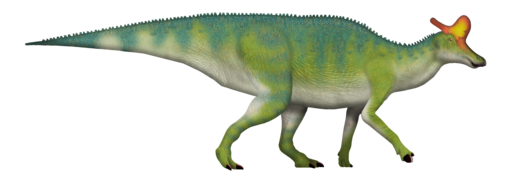The Crested Duck-Billed Dinosaur
Lambeosaurus was a unique herbivorous dinosaur that lived during the Late Cretaceous period, about 75 to 70 million years ago.

| Meaning | Lambe’s lizard (named after Lawrence Lambe) [Lambeo-saurus] |
| Pronunciation | LAM-bee-oh-SORE-us |
| When: | Late Cretaceous (about 76–75 million years ago) |
| Where: | North America (Canada, USA) |
| What: | Hadrosaur (duck-billed herbivorous) |
| Weight: | Estimated around 5 metric tons |
| Length: | Approximately 9–15 meters (30–49 feet) |
| Diet: | Herbivorous (ate plants and leaves) |
| Discovered: | First described by William Parks in 1923 |
It is well-known for its distinctive cranial crest, which varied in shape and size among different species and individuals.
Fossils of Lambeosaurus have been primarily found in North America.
Lambeosaurus was a member of the hadrosaurid family, often referred to as “duck-billed dinosaurs” due to their broad, flattened snouts.
It measured around 9-15 meters (30-50 feet) in length and weighed up to 5 tons.
The most striking feature of Lambeosaurus was its hollow, bony crest on top of its head, which may have been used for communication, mating displays, or even as a resonating chamber to produce sounds.
This dinosaur had a herbivorous diet, feeding on plants with the help of its specialized teeth adapted for grinding and chewing tough vegetation.
Lambeosaurus likely lived in herds, providing protection against predators and facilitating social interactions.
